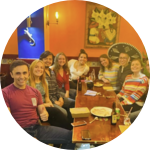About This Project
This project introduces the integration of nano plastic waste into concrete mixtures. By harnessing the potential of concrete as a containment matrix, we unlock the power to reduce nano plastic dispersion into ecosystems while promote sustainable construction practices. This groundbreaking approach not only addresses a pressing global pollution issue but also propels us closer to a sustainable, circular economy where waste finds new life as a cornerstone of construction for the future.
Ask the Scientists
Join The DiscussionWhat is the context of this research?
Nanoplastics originate from a variety of sources, including a breakdown of larger plastic items, microplastic fragmentation, and the release of engineered nanomaterials. These tiny particles can be dispersed through air, water, and soil. According to Nature Nanotechnology, at least 79 (45–129)thousand tonnes of ocean plastic are floating in an area of 1.6 million km2.
The risks associated with nanoplastics are a subject of ongoing research and concern, as these tiny particles have the potential to impact the environment and human health. Some of the known and potential risks of nanoplastics include human inhalation and ingestion, potential toxicity for human cells and absorption through the human body with the risk of inducing severe diseases in the function of the frequency.
What is the significance of this project?
Nano plastics are a growing concern in terms of pollution, and incorporating them into concrete prevents their widespread dispersion in ecosystems, reducing their environmental impact.
Utilizing waste materials, such as nano plastics, in construction aligns with sustainable building practices. It reduces the demand for virgin aggregates and can contribute to more eco-friendly construction processes, addressing sustainability goals.
Nanoplastics can improve certain properties of concrete. They can act as reinforcement, enhancing the material's strength and durability. Additionally, the addition of nanoplastics may improve the flexibility and crack resistance of concrete, leading to longer-lasting and more resilient structures.
What are the goals of the project?
The objective of this project is to procure nano plastic pellets from municipal waste sources, including those within the UK. Once we have gathered these nano plastics, we will carefully integrate them into a concrete mixture using appropriate techniques, aiming to enhance the mechanical properties of the concrete by incorporating recycled materials from municipal waste sources.
After the sustainable concrete samples have been prepared and allowed to cure, we will employ intricate measurement techniques, including photoelasticity, to assess the mechanical properties of the concrete samples and evaluate the feasibility of this innovative construction material.
Budget
Our research addresses the urgent issue of nano plastic pollution by integrating nano plastics into concrete. This represents a crucial step toward sustainable construction practices and environmental protection.
The substitution with nano plastics from waste incinerators is expensive and complex. We employ photoelastic coatings to measure the fracture toughness of concrete specimens using photoelasticity. High-resolution cameras capture the fracture processes, and a polariscope is used to determine material strength through polarized light analysis. Strain gauges complement these measurements. These measurement materials are essential to safeward the structural stability of the infrastructure using our concrete mixtures.
To gain a comprehensive understanding, we utilize the advanced facilities at the University of Leeds, employing techniques like X-ray diffraction and spectroscopy to analyze the concrete mixture at a molecular level.
Endorsed by
 Project Timeline
Project Timeline
The completion of this project should be accomplished no later than July 2024. Initially, we will request nanoplastic materials from municipal and industrial waste sources by December 2023. Subsequently, we will proceed to develop concrete prototypes using the sustainable mixture. These two tasks will be finalized by April 2024. Following the curing of the samples, we will conduct mechanical property measurements and compile academic reports by June 2024.
Sep 25, 2023
Project Launched
Dec 15, 2023
Gathering materials for the preparation of samples.
Apr 26, 2024
Elaboration of the concrete samples by incorporating recycled nanoplastics.
Jun 28, 2024
The mechanical testing, conducted through the utilization of photoelasticity, aims to assess the viability of the tested samples.
Meet the Team
Victor Efren
As a passionate advocate for natural sciences with a profound interest in the realms of chemistry, physics, and mathematics, I have been resolutely committed to forging a career path in the domain of civil engineering and construction management. My journey commenced with undergraduate studies in civil engineering, followed by the pursuit of a master's degree specializing in hydrodynamics and coastal engineering. These formative academic experiences have played an instrumental role in shaping my professional trajectory.
Simultaneously, my extensive professional experience has underscored the imperative to address the ecological footprint generated by such ambitious projects, particularly in the production and utilization of construction materials. My understanding of this critical concern is further accentuated by my familiarity with the Mexican norm governing environmental protection in the manufacture of hydraulic cement, which establishes permissible emissions levels, underscoring the paramount importance of responsible resource management.
My unwavering commitment is to champion sustainable development—a delicate equilibrium that harmonizes progress and environmental preservation. My experiences have instilled in me a profound sense of responsibility to bridge the gap between industrial advancement and ecological stewardship. Thus, I felt compelled to embark on a new chapter in my academic and professional journey—a pursuit that led me to enroll in a Ph.D. program at the University of Leeds, specializing in composite materials, circular economy principles, material efficiency, waste treatment, and reuse.
Lab Notes
Nothing posted yet.
Project Backers
- 4Backers
- 2%Funded
- $150Total Donations
- $37.50Average Donation

